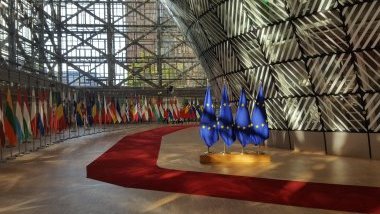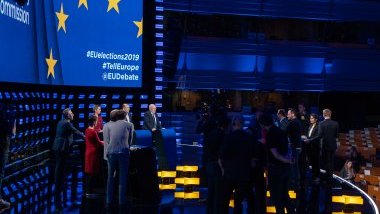The Spitzenkandidaten system, instead of being reinforced, has been shut out
When the Spitzenkandidaten format was introduced back in 2014, it really seemed like that long-awaited rapprochement between institutions and citizens was finally coming. The European electorate was finally conscious of what candidate for the presidency of the European Commission their vote was going to. Or at least, the process for the electorate to be conscious of it, and for a genuine European electorate in a European public sphere to emerge, was there.
Ideally, as the process was triggered, the logical development would have been to make the citizens aware of the existence of these “lead candidates”, for them to be able to listen to their ideas, to their programme, to their vision for the EU. In short, to have an informed vote and to be aware of their influence. In the absence of a process directly electing the President of the EU’s executive body, at least the European citizens could indirectly decide, as the Spitzenkandidaten system implied, that the candidate of the party (or the coalition, the door was open) winning the elections would be elected Commission President.
However, a few weaknesses were part of the process from the very beginning. The first one was institutional: the process was not binding. The Treaty only mentioned that the European Council has to “tak[e] into account the elections to the European Parliament” when proposing to the European Parliament a candidate for President of the Commission.
In practice, this was translated into the Spitzenkandidaten system in 2014, but the system had an institutional weakness from the beginning: “taking into account” is so vague, that it can be translated into the Spitzenkandidaten system (which was a democratic step forward) or into anything else (like a mere opaque consultation within the Council, and this is exactly what happened yesterday evening).
The second weakness was a structural one: the process was not known well enough by the European citizens. The Spitzenkandidaten debates were not broadcast in mainstream national media (the French national TV even refused to broadcast them), whether on TV, radio, or in the press. The MEP candidates in the different member states and their respective national parties did not bother, for the most part, to enhance their European affiliation and their European candidate. Like so often, the public sphere remained largely dominated by national debates, national political parties, national politicians. Quite a pity for a European election.
But well, in 2014, the Spitzenkandidaten process was established. If you voted for the European People’s Party, Juncker would be your candidate of choice; if it was the Socialists and Democrats, Schulz; if it was the Liberals, Verhofstadt… The Spitzenkandidaten were a new, non-written rule, a gentleman’s pact, and as any such pact it had to be staunchly defended in the European Council. That time things went well and it was finally Jean-Claude Juncker who was chosen to get voted on by the EP.
The European Parliament balked backing more democratic processes for the EU
For the next 5 years the efforts to deepen in that model of pan-European democracy came and went through the proposal to establish transnational lists, a true Europeanisation of the European Parliament with an additional single constituency. But the unthinkable happened, and the Parliament itself shot down the transnational lists even before it could lift off towards the Council. The parliament that had fought so hard for the Spitzenkandidaten, to take Europe closer to everyday citizens, was turning around. Few of us imagined what was about to come.
We get to the 2019 elections, with the big parties again nominating their Spitzenkandidaten, and finally the 26th of May arrives. For the first time, with a deeply fragmented European Parliament, it seems that the legislature will finally become a space for negotiation, a place for agreements. But the Council no longer had the knights willing to fight for the Spitzenkandidaten mechanism with 2014-style willingness (or strength to do so) among its ranks. And that’s how Ursula Von der Leyen, the German Minister of Defence, appears, with the nomination for the presidency of the European Commission. The Spitzenkandidaten mechanism was wounded.
Even so, there was a last line of defence still standing, the last guarantor of European democracy: the European Parliament. Despite the European Council’s stabbing, there was a chance still left for the elected representatives of the European people to stand up and say clearly that it was up to the Parliament to decide who should be the next person at the helm of the European Commission. Backroom deals had died in 2014 and 2019 was to be the nail that would seal its coffin.
The European Parliament (the previous one, actually) had claimed that it would not endorse a Commission President who would not have been a Spitzenkandidat. The institution did not keep its promise. Even worse, it endorsed a stranger, unknown by the European citizens, including the MEPs! Ursula Von Der Leyen might be competent for the job, who knows? But that’s the whole point actually: we don’t know, because we did not get the chance to see her campaigning, to hear her ideas, her vision, to forge our opinion… In short, we were denied a voice on the presidency of the European Commission.
If only the candidate had been, if not a Spitzenkandidat, at least someone known by the citizens, someone who proved their European engagement, someone who delivered public speeches to display their vision, and someone from the winning party or party coalition (let’s be honest, Michel Barnier was more well-known and worked more for Europe than some of the Spitzenkandidaten), here the pill would have been less difficult to swallow.
But instead, we ended up with a stranger, with a weak parliamentary majority and no democratic endorsement from the citizens. After spending months campaigning with the Young European Federalists for more democratic processes and for better-informed citizens, needless to say that this episode leaves a bitter taste in the mouth.
When it came to the crunch the Parliament wasn’t up to it. With a slim majority, the European Parliament, the house of European citizens, again validated backroom deals. And this it how, only two weeks into its term, this has become the parliament that didn’t want to stand up for democracy.









1. On 17 July 2019 at 10:17, by Ian Beckett Replying to: The Parliament that didn’t want to stand for democracy
Replying to: The Parliament that didn’t want to stand for democracy
And don’t forget, it may have been voters of British MEPs that got Von der Leyen across the finish line, her mandate is actually significantly weaker than it first looks.
Tell us again about EU values of diversity (unbelievably low levels of non white MEPs, and a third of those are from the UK), rule of law and democracy. Perhaps we could have another chorus of that classic, ’we will reform the EU’.
Follow the comments: |
|
